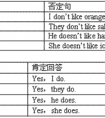用所给单词的适当形式填空。1. There ____________ (be) four seasons in a year. 2. What a cold, ____________ (snow) day!3. Look! Snow is ____________ (fall).4.-六年级英语
题文
| 用所给单词的适当形式填空。 |
| 1. There ____________ (be) four seasons in a year. 2. What a cold, ____________ (snow) day! 3. Look! Snow is ____________ (fall). 4. Today is Friday, November ____________ (nine). 5. Lily likes the rain, but she ____________ (not) like to get wet. |
答案
| 1. are 2. snowy 3. falling 4. ninth 5. doesn't |
据专家权威分析,试题“用所给单词的适当形式填空。1. There ____________ (be) four s..”主要考查你对 there be 句型,年月日,形容词,现在进行时,现在分词,助动词 等考点的理解。关于这些考点的“档案”如下:
there be 句型年月日形容词现在进行时,现在分词助动词
考点名称:there be 句型
- There be句型:
是英语中常用句型,意思是“有”,表示“人或事物的存在”。
There在此结构中是引导词,已经没有副词“那里”的含义。
There be后面的名词是句子的主语,属倒装结构。常用“There + be+名词+地点/时间状语”的结构。 - There be结构的用法:
A、肯定结构:
There be句型的肯定结构表示“某处存在某物或某人”或“某时发生某事”。
a. There is+单数可数名词/不可数名词+地点/时间状语。
例:There is a cat under the chair. 椅子下面有一只猫。
There is some water in the bottle. 瓶子里有些水。
b. There are +复数名词+地点/时间状语。
例:There are some apples in the basket. 篮子里有一些苹果。
B、否定结构:There be句型的否定结构是在谓语动词be的后面加“not (any)”或“no”.
例:There are no tables in the room. 或者There are not any tables in the room. 房间里没有桌子。
C、疑问结构:There be句型变成疑问式时,要把there和谓语动词be的位置互换。
例:Is there a pen in the schoolbag? 书包里有一支笔吗? - Therebe结构和have的区别与联系:
1.区别点:
there be 意为存在,强调某地有某物,不表示所属关系;
have 表示所有关系, 强调某人或某地有某物,这是其基本用法。如:
There are some trees in front of the house.房前有些树。
Tom has many friends in China.汤姆在中国有许多朋友。
2.相同点:
在表示结构上的含有时,既可以用there be 句型,也可以用have(has) 来表示。如:
中国有许多长河。
There are many long rivers in China.
China has many long rivers.
三月份有多少天?
How many days are there in March?
How many days has March? - There be结构中的be动词的确定:
A、there be 结构中的谓语动词be在人称和数上应与其后的主语保持一致。主语是不可数名词或单数可数名词时用is,是复数时用are。
例:There is a flower in the bottle. 瓶里有一朵花。
There is some money in the purse. 钱包里有些钱。
B、若句子中有几个并列的主语时,be的形式要与离其最近的一个主语在人称和数上保持一致。
例:There is a boy, a girl and two women in the house. 房子里有一个男孩,一个女孩和两个妇女。
There are ten students and a teacher in the office. 办公室里有十个学生和一个教师。
There be结构的句型转换:
A、否定句:
there be的否定式通常在be后加not构成(在口语中be时常与not缩写在一起)。如果句中有some,一般要变成any。 例:
There are some children in the picture.
There aren't any children in the picture.
B、一般疑问句及其答语:
把be提到there前,首字母大写,句末用问号即可。其肯定答语是Yes, there is / are;否定答语为No, there isn't / aren't。 例:
— Are there two cats in the tree?
— Yes, there are. (No, there aren't.)
C、特殊疑问句及其回答
a. 提问句子的主语(包括主语前的修饰语)时,句型一律用“what is+地点介词短语?”(无论主语是单数还是复数都用is)。
例:There are some birds in the tree. → What's in the tree?
b. 就there be后面的地点状语进行提问时,句型用“where is/ are+主语?”
例:There is a car in the street. → Where is the car?
c. 提问可数名词(主语)前的数量时,用how many,句型结构为“how many+ 复数名词+are there+其它)”(主语无论是单数还是复数,be通常要用are)。
例:There are three books on the desk. → How many books are there on the desk?
考点名称:年月日
一、年份
1、年份表达一般分为两个单位来读,前两个数为一个单位,后两个数为一个单位。
如:1982年读作nineteen eighty-two, 1900年读作nineteen hundred。
2、如果是三位数,先读第一位,再把后两个数合起来读。
如:984年可读为nine eighty-four , 757年读成seven fifty-seven。
3、关于四位数年份的读法有下列几种情形:
(1) 一般情况下,将表示年份的四个数字按前后分为两组,每一组的数字都按基数词来读。
1865年读作 eighteen sixty-five
1998年读作 nineteen ninety-eight
(2) 如果是整百的年,后面的两个“零”读为 hundred。
1900年读作 nineteen hundred
1800年读作 eighteen hundred
(3) 十位数字上为“零”,该“零”读为字母O的发音。
1809年读作 eighteen O nine
(4) 关于千年的一些读法。
2000年读作 two thousand 或 twenty hundred
2008年读作 two thousand and eight 或 twenty O eight
1008年读作 one thousand and eight 或ten O eight
(5) 三位以内数字的年份,它们有两种读法:一种是按照基数词的方法来读,另一种是一个一个数字来读。
531 BC 读作 five three one BC /five hundred and thirty-one BC二、日期
日期的写法可以采用基数词和序数词两种形式。
例如: March 1也可以写成March 1st;May 29也可以写成May 29th。
但是,日期的读法只能用序数词的形式。例如:
October 31(October 31st)读作October(the)thirty-first
August 26(August 26th)读作August(the)twenty-sixth三、月份表达:
January n. 一月,正月(略写为Jan.)
February n. 二月(略写为Feb.)
March n. 三月(略写为Mar.)
April n. 四月(略写为Apr.)【引申】April Fool’s Day愚人节(每年的四月一日)。
May/mei/ n. 五月
June n. 六月(略写为Jun.)【记忆法】由罗马神话中婚姻女神朱诺Juno而得名。
July n. 七月(略写为Jul.) 【记忆法】由于罗马将军尤里乌斯?凯撒Julius Caesar生于七月,而得名。
August n. 八月(略写为Aug.) 【引申】此词源自罗马第一位皇帝奥古斯都Augustus的名字。
September n. 九月(略写为Sept.)【记忆法】September源自拉丁文的“7”sept,在早期的罗马历中为7月,后因历法的修正而成为9月。
October n. 十月(略写为Oct.)
November n. 十一月(略写为Nov.)
- 最新内容
- 相关内容
- 网友推荐
- 图文推荐
| [家长教育] 孩子为什么会和父母感情疏离? (2019-07-14) |
| [教师分享] 给远方姐姐的一封信 (2018-11-07) |
| [教师分享] 伸缩门 (2018-11-07) |
| [教师分享] 回家乡 (2018-11-07) |
| [教师分享] 是风味也是人间 (2018-11-07) |
| [教师分享] 一句格言的启示 (2018-11-07) |
| [教师分享] 无规矩不成方圆 (2018-11-07) |
| [教师分享] 第十届全国教育名家论坛有感(二) (2018-11-07) |
| [教师分享] 贪玩的小狗 (2018-11-07) |
| [教师分享] 未命名文章 (2018-11-07) |




